Bulletin – March 2015 Global Economy China's Property Sector
- Download the article 350KB
Abstract
Property development, especially of residential property, represents a sizeable share of China's economic activity and has made a considerable contribution to overall growth over recent history. Residential property cycles in China have been larger than cycles in commercial real estate, and may pose risks to activity and financial stability. The current weakness in the property market differs somewhat from previous downturns as there are indications that developers may be much more highly geared than in the past, contributing to financial stability risks. Although urbanisation in China may provide support for property construction in coming years, weakness in the residential property market is likely to persist. Policymakers have taken actions to support activity and confidence in the market, and have scope to respond with further support if needed. However, broader concerns about achieving sustainable growth may limit the scale of any stimulus they are willing to provide to the sector.
Background
Private property markets are still a relatively new phenomenon in the People's Republic of China, having been established through a series of reforms beginning in the early 1980s.[1] Prior to this period, all property was publicly owned, and the state operated as both a developer and landlord; urban housing was allocated by employers on the basis of seniority and family size. From 1980, the government began to experiment with private property rights for individuals, and in 1988 the State Council (China's central legislative body) officially announced its intention to reform the sector by establishing a housing market. The national constitution was amended to allow land-use rights to be purchased and traded, and as part of state-owned enterprise reforms of the 1990s, many households were allowed to purchase the apartments formerly assigned by work units.[2] In 1998, the State Council abolished employer-allocated housing and introduced a range of methods for households to finance the purchase of property. These reforms led to the transfer of a large proportion of the urban residential housing stock into private hands (Yang and Chen 2014).
Despite the continued development of private property markets, a considerable share of property constructed in China is not freely traded. In urban property markets, tradable, or ‘commodity’ properties, are constructed by developers on land acquired at public auctions.[3] Buyers of these properties have the transferable right to occupy, rent or sell the premises for a specified, lengthy leasehold period (although not, in theory, in perpetuity) (Wu, Gyourko and Deng 2012).[4] Around 70 per cent of residential property constructed is ‘commodity’, while for other types of property, such as offices and factories, the share is around 30 per cent.
A considerable share of the recently constructed urban housing stock has been social housing. The Chinese Government's social housing program is designed to provide affordable housing to lower-income households. It includes both housing for sale below market prices and subsidised rental housing. In recent years, there were around 5 million social housing units completed per annum in urban areas, and around 7 million ‘commodity’ residential property completions.[5]
Households have historically purchased property using savings, rather than through credit, and the Chinese mortgage market is highly regulated. Down payment requirements for mortgages have varied over time, depending on government policy, but are typically 30 per cent for first homes and 60 per cent for additional properties. Interest rates on mortgages are quoted relative to a benchmark lending rate set by the People's Bank of China (PBC); banks can only offer rates above a certain multiple of the benchmark rate, as determined by the PBC. Mortgage rates also differ depending on whether the loan is for a first property.
Notwithstanding China's high home ownership rate, which was estimated at close to 90 per cent in urban areas in 2014 (Li 2014), in recent years there has still been considerable demand for new residential property development. This demand has been driven by a range of factors. First, although China's urbanisation rate has risen from 42 per cent to 55 per cent over the past decade, it is widely expected to rise further, and the Chinese authorities have announced a target of 60 per cent for 2020 (State Council 2014). Second, while population growth has been declining and is projected to slow further (UN 2013), the average household size has also been falling. This is consistent with the replacement of multigenerational households with ‘nuclear family’ households, and implies that more stock is required to house the population. Third, much of the existing housing stock is of low quality. A survey conducted as part of the 2010 census found that 16 per cent of urban households had no access to toilet facilities, and that 10 per cent lacked a kitchen. Demand for replacement and upgrading of housing is likely to provide some support to dwelling investment growth in coming years.
Another driver of demand for residential property has been household investment. Notwithstanding relatively low rental yields, the limited investment alternatives make residential property an attractive store of wealth for households. In addition, although the government levies taxes on property transactions, there are currently no recurrent taxes on residential property.[6] This preference for housing as a store of value may, however, change as China's financial markets deepen and opportunities for investment at home and abroad develop further.
Many of these same forces also drive the demand for non-residential property. As population centres have grown due to rising urbanisation, the influx of residents has underpinned demand for a range of non-residential property, such as factories, offices, shopping malls and other forms of retail space. Although the costs of holding commercial property are higher than for residential property (with recurrent taxes levied on commercial properties), commercial real estate assets can also be attractive to institutional investors. Some financial institutions and their subsidiaries are permitted to hold commercial property, and insurers may hold up to 10 per cent of their assets as office and retail property.
Rapid growth over the past decade has meant that real estate development now makes up a large share of investment in China, accounting for around one-quarter of total fixed asset investment (FAI) in 2014 and around 12 per cent of GDP in 2013 (and higher according to some estimates).[7] About two-thirds of this investment was directed to residential property, with the remainder going to commercial and retail buildings (15 per cent), office buildings (6 per cent) and other types of buildings (11 per cent).[8] According to the 2010 census, persons employed in the real estate and construction sectors accounted for around 8 per cent of urban employment.
Trends in the Property Market
Historically, property prices in China have displayed a strong cyclical pattern (Graph 1). Despite the price falls seen during cyclical downturns, the national average residential property price has risen by at least 50 per cent over the past decade.[9] This growth has led the authorities to become more concerned about housing affordability. Although prices in most major cities have followed broadly similar cycles, the rates of price growth have varied across cities of different sizes. Until recent months, residential property price growth had been particularly strong in the very large ‘first-tier’ cities of Beijing, Guangzhou, Shanghai and Shenzhen (Graph 2). Growth in ‘second-tier’ cities and 45 other smaller cities had not been as strong. First-tier, second-tier and these other cities have populations averaging around 17, 9 and 5 million persons, respectively.[10] Notwithstanding the large size of first-tier and second-tier cities, the majority of urban property sales, as measured by floor space sold, occur outside of those cities (Graph 3).
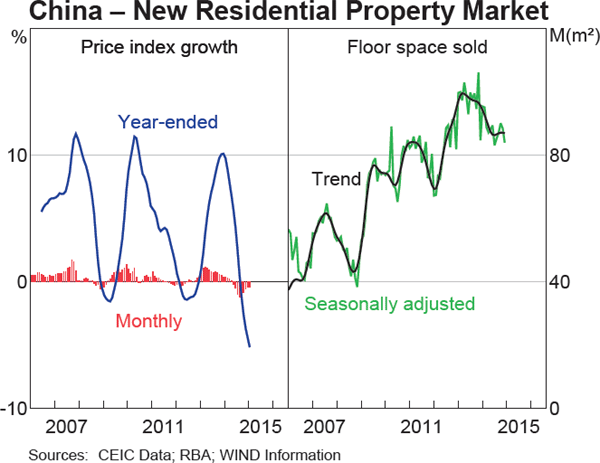
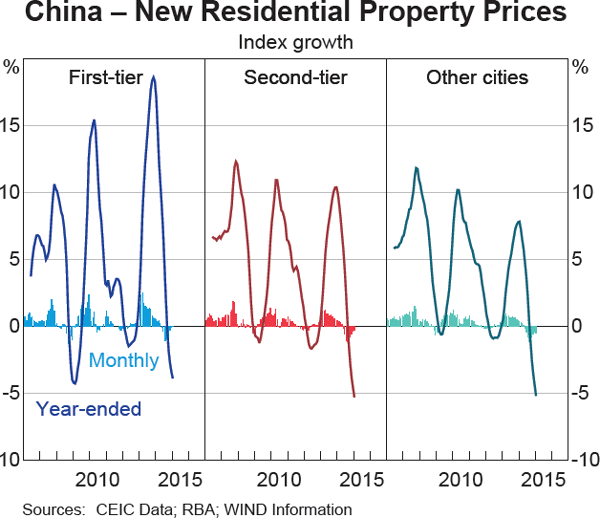
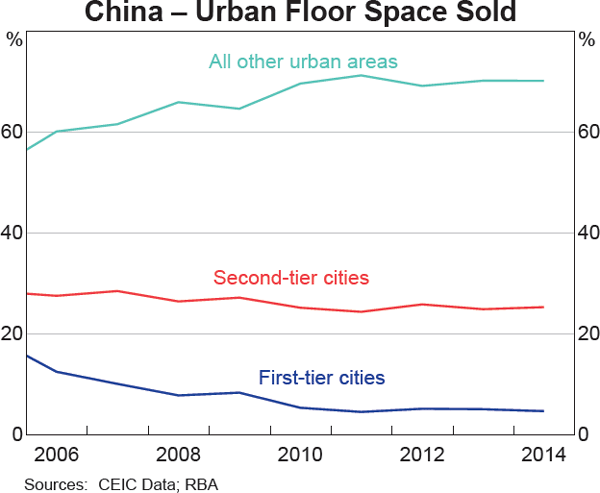
Based on data available for 10 cities, price growth cycles for office and retail buildings exhibit somewhat similar patterns to that observed for residential property prices (Graph 4).[11] However, recent cycles have been more subdued than those seen in the equivalent residential property markets. Investment in residential and non-residential property also tend to follow a similar cycle, although growth of non-residential investment is more volatile (Graph 5).
The Chinese property market entered its most recent downturn in 2014, with a broad-based decline in prices across the country. Between April and December, average residential property prices in major cities fell by 5 per cent, to be 4 per cent lower in year-ended terms.
The three major price cycles over the past decade have coincided with a range of government policies aimed at stimulating or dampening activity in the residential property market (Table 1). These policies have attempted to constrain demand when prices have been rising rapidly, and to support demand when price growth has weakened. The authorities have also implemented measures aimed at boosting supply during times of strong demand. While many of these policies are directed by the central authorities, over the years the State Council has instructed local governments to take more responsibility for ensuring the stable and healthy development of local property markets (State Council 2011, 2013). Continued challenges faced by the Chinese authorities include improving housing affordability and discouraging speculative activity in the property market. Property cycles are also affected by broader economic conditions, for example the global financial crisis, during which prices, sales volumes and investment all weakened (see Graph 1 and Graph 5).
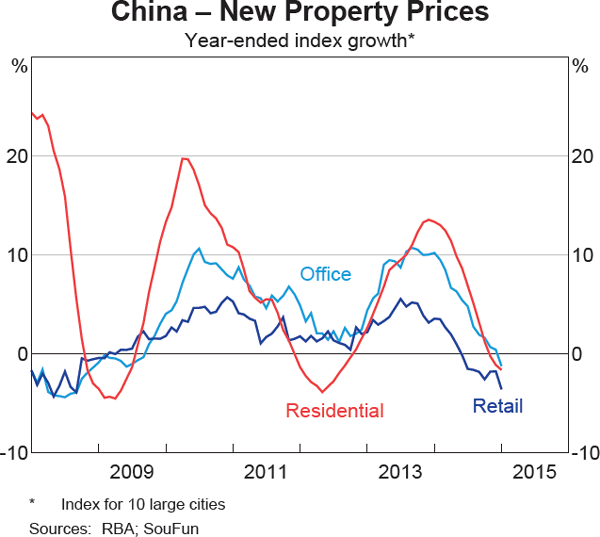
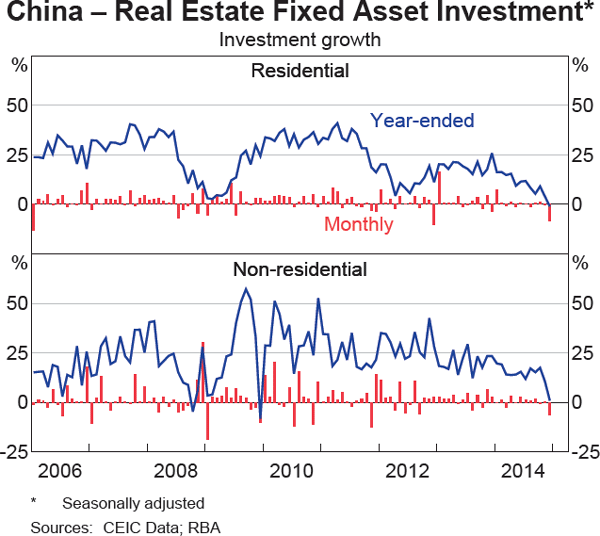
| Cycle | Date | Measures | Goal |
|---|---|---|---|
| 2006–2009 | Late 2007 | Increase benchmark interest rates Increase minimum down payment requirement for second home mortgage Increase minimum interest rate for second home mortgage |
Tighten |
| Late 2008 and early 2009 |
Lower minimum down payment requirement Lower interest rate for first home mortgages Provide interest rate discounts for borrowers with a good credit rating Lower several property transaction-related taxes Allow some second home mortgages to be treated as first home mortgages (which have more favourable terms) |
Stimulate | |
| 2010–2012 | 2010 | Increase benchmark interest rates Increase minimum down payment requirement for first, second and third home mortgages, and later suspend third mortgages Increase interest rate for second mortgage 78 state-owned enterprises whose core business is not property ordered to exit the market Local governments in around 50 cities introduce limits on the number of properties people can purchase based on their existing holdings In some cities, purchases by non-residents banned |
Tighten |
| 2011 | Increase benchmark interest rates Increase minimum down payment requirement for second home mortgages Increase interest rate for second mortgage |
Tighten | |
| 2012 | Lower minimum interest rates Some local governments ease first home buyers' access to finance, such as lowering of mortgage down payment requirements |
Stimulate | |
| 2013– | 2013 | Increase minimum down payment requirement for first and second home mortgages,
ban on mortgages for third homes Local authorities given more autonomy to manage local mortgage conditions as needed |
Tighten |
| 2014 | Local authorities unwind house purchase restrictions, allow investors to
buy additional properties and non-residents to purchase housing; by the
end of the year, restrictions remain in only the four ‘first-tier’
cities Redefine first home buyers to include those who have already paid off their first mortgage, to meet lower down payment requirements Lower minimum interest rates for mortgages |
Stimulate | |
|
Source: RBA |
|||
Implications for Developers
Property market conditions can have a substantial impact on real estate developers and their activities. Data from the NBS show that there were over 91,000 real estate enterprises in China in 2013. Collectively, these firms had total assets worth 72 per cent of the value of GDP. However, it is likely that this includes a range of firms, such as real estate services providers, as well as developers, and limited information is available about the financial health of most of these individual enterprises.
Financial reports of listed property developers are one of the most detailed sources of information on the impact of current conditions on the real estate developer sector.[12] These listed firms account for around 10 per cent of total sales and around 6 per cent of total assets of developers, so they are not necessarily representative of the sector. Nevertheless, for these listed firms, the current property cycle is differentiated from previous cycles by the unprecedented rise in leverage, which has coincided with a decline in profitability and a rise in inventories. Aggregate gearing for listed real estate developers in 2014 was considerably higher than for listed firms outside the sector (Graph 6). This has largely been driven by higher levels of long-term debt, which constitutes three-quarters of debt outstanding; the level of cash holdings remains high, but has grown very little since the start of 2013.
Over the past decade, the profits of listed developers have grown strongly, with a sharp rise in aggregate profitability over 2006 and 2007 (Graph 6). Profitability declined a little following the 2007–08 downturn, although it quickly recovered. Profitability improved again in 2013, but has since fallen. Despite this, the share of firms facing losses remains around its average since 2010. Listed developers appear to have suffered less than listed firms in other sectors in the period after the global financial crisis and to have been more profitable than other firms in China since 2012, although the gap in profitability is narrowing.
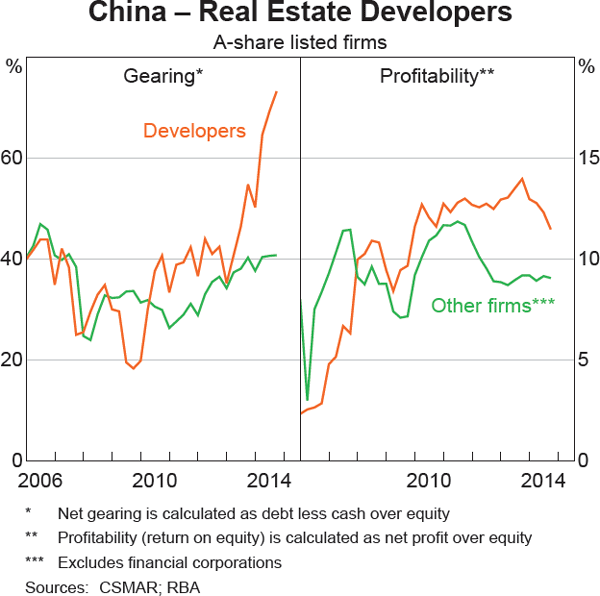
The value of listed developers' inventories as a proportion of revenue increased significantly in the years prior to 2011, and has fluctuated at around those levels since (Graph 7). A large share of residential property is sold ‘off the plan’ in China, which provides developers with advance cash flow in the form of prepayments. Adjusting for this, the ratio of ‘unsold’ inventories to revenue is considerably lower. While the unsold inventory ratio has risen somewhat over 2014, it has been at similar levels previously. Rising inventories among listed property developers are consistent with reports of a growing number of unsold properties in urban areas. Such reports suggest that the ratio of housing inventory to sales in 2014 was greatest in the smaller cities of China, with excess inventory problems not as large in the first- and second-tier cities (IMF 2014).
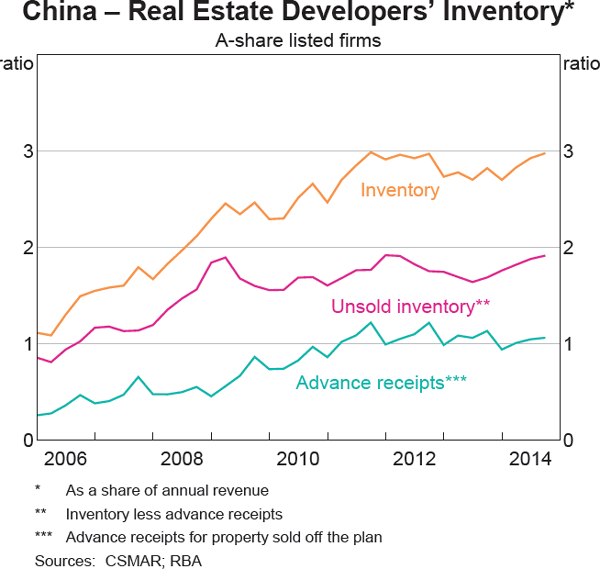
Rising leverage among listed developers has coincided with a broad-based weakening of funding sources available to developers. Authorities have attempted to curb loan growth by limiting developers' access to bank lending since 2010 (Graph 8). However, there has been an increase in the growth of credit to developers since 2012, largely due to loans intended for the development of social housing, which coincides with the authorities' expressed support for the construction of social housing (State Council 2013).[13] Reports suggest that informal restrictions on lending to developers were tightened in 2010 in response to concerns about credit risk and that lending to developers has continued to be monitored closely.[14] Indeed, data on the sources of funds used for real estate investment show that growth of domestic loans has been much slower than for some other sources of funding over the past few years, particularly ‘self-raised’ funds, which include a range of non-bank funding sources (Graph 9). A considerable share of funds raised by property developers comes from outside the formal banking sector, including from trust companies and entrusted lending (bank-intermediated intercompany finance), the bond market and other lending channels.[15] Over the past few years, the second largest source of funds for real estate investment has been deposits and advance payments, growth of which follows a somewhat similar cycle to property prices.
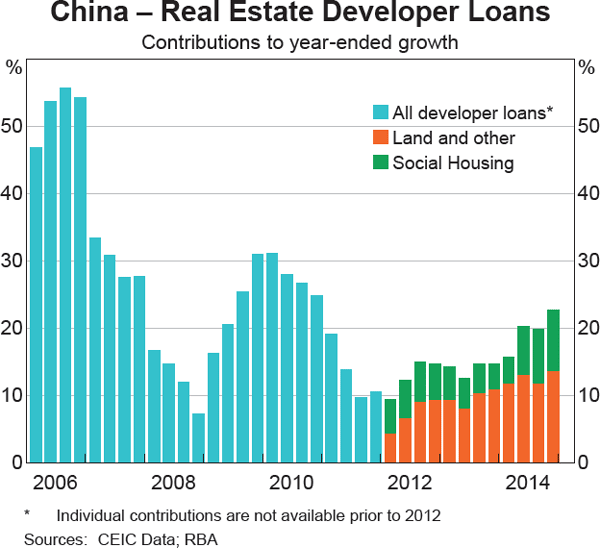
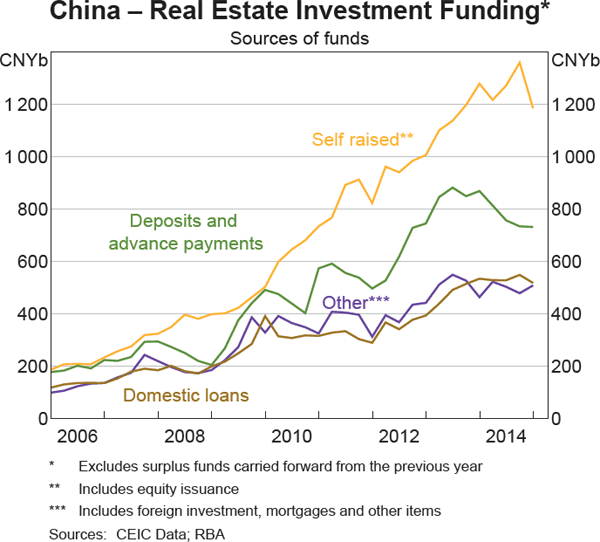
Potential Risks
As construction investment represents a sizeable share of China's economic activity, weaker conditions in the property market, and particularly the residential market, are likely to exert downward pressure on economic growth. Weakness in the property market has the potential to affect not only property investment, but also activity in sectors that supply building inputs such as steel and cement. Weaker demand for steel could influence imports of raw materials such as iron ore and coking coal, which account for a significant share of Australia's trade with China.[16] In addition to direct effects on the Chinese construction industry and associated imports of commodities, subdued property market conditions could also affect the downstream consumption of real estate services and complementary goods, such as white goods and furniture. To the extent that a decline in property prices affects the wealth of households, it could also have an impact on the growth of household consumption.
The direct exposure of the banking sector to the real estate market is moderate; household mortgages and loans to property developers represent about 14 and 7 per cent of banks' lending, respectively. China's high savings rate and the large minimum down payment requirements for mortgages mean that households are not highly leveraged. However, weakness in new residential property sales can place pressure on real estate developers' balance sheets, and there is a greater chance of financial losses in the event of a sharp decline in the housing market. Although property developers raise sizeable funds outside the banking sector, the banks are ultimately intermediating much of this lending and so are also exposed to this risk indirectly. To the extent that regulatory supervision and internal risk assessment is weaker for some of these funding channels than for the formal banking sector, there is a greater chance of financial losses in the event of a sharp negative correction in the property market.
A more general risk to the financial system relates to the correlation between residential property prices and land values. Local governments have been responsible for much of the infrastructure investment and construction spending in China. Moreover, most have relied heavily on revenue from land auctions, and proceeds of land rights auctions account for about a third of combined local government revenue (Graph 10).[17] To the extent that weaker conditions in the property market lead to reduced expenditure on land and falls in land prices, this could reduce overall fiscal revenues and constrain local government-led investment in infrastructure and property. Much of this investment is conducted on behalf of the authorities by local government financing vehicles, which rely on land as collateral when they borrow funds. Land is also an important source of collateral for financing in China more generally, so widespread and sustained declines in land prices could have broader implications for financial stability. Available measures of land price growth suggest that the market is in a downturn phase of the cycle (Graph 11).[18]
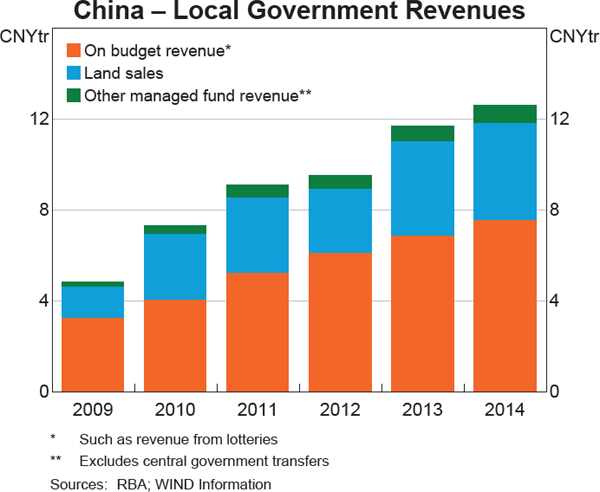
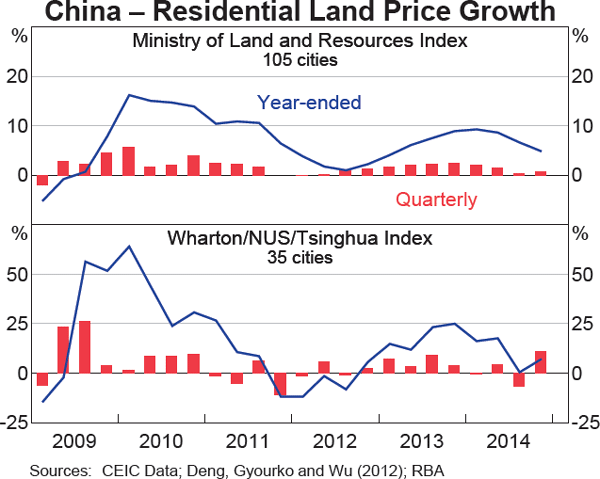
The Chinese authorities have responded to the latest downturn with a range of policies intended to support the market. These have included relaxing restrictions on the purchase of residential property, easing lending policies for borrowers and actively encouraging banks to lend to financially sound development projects. Naturally, policymakers also have the scope to ease credit conditions for developers, which could be expected to provide further support for activity in the sector, although this would run counter to broader efforts to slow the accumulation of economy-wide leverage. The Chinese Government has repeatedly expressed a desire to manage the risks associated with reliance on debt as a source of economic growth and to avoid excessive stimulus that might increase leverage and worsen structural distortions (PBC 2014). Authorities have also reiterated a need for steady, sustainable and ‘higher-quality’ growth (Li 2015). These concerns suggest that there may be limits to the scale of any additional policy response to the current weakness in the property market.
Conclusion
Conditions in the Chinese property market, including the outlook for new property construction, are relevant for Australia given that sector's use of raw materials such as iron ore and coking coal that Australia exports to China. The latest slowdown in the property market has coincided with a pronounced increase in property developer leverage and remains a key risk to Chinese economic growth, financial stability and imports of resource commodities. While the process of urbanisation in China is continuing and will provide a level of support for construction activity in coming years, the property market is likely to remain weak for a time. Various levels of government have taken actions to support activity and confidence in the market. If needed, there is scope for the authorities to respond with further support, but the goals of deleveraging and achieving sustainable growth may limit the extent to which policymakers are willing to provide further stimulus to the sector.
Footnotes
The authors are from Economic Group. This work benefited from earlier internal work undertaken within Economic Group by Kelsey Wilkins. [*]
Private property markets have largely been an urban phenomenon in China, and so this article focuses on the urban property sector. [1]
Historically, a government-controlled work unit, or danwei, was responsible for providing members with employment, housing, social security, education and welfare. [2]
Commodity property refers to property developed for sale to third parties, in the sense of Marx (1957). [3]
All land in China is still publicly owned, and land rights refer to the right to lease and use the land, rather than to the land itself. Residential land rights are for up to 70 years, while leases for commercial purposes are generally limited to 40 years, or 50 years for industrial purposes. [4]
There is likely to be some overlap between these two categories of property completions. [5]
Some property tax trials have been implemented in Shanghai and Chongqing, and a recurrent tax may be expanded to more regions of China in the future. [6]
This calculation is subject to considerable uncertainty, as real estate FAI includes land sales and asset transfers, which would not normally be included in a national accounts measure of investment. Multiplying the ratio of real estate industry FAI to total FAI by the overall investment-to-GDP ratio suggests that real estate investment could make up around 12 per cent of GDP. Some authors report higher estimates: for example, the International Monetary Fund reports a share of 13 per cent of GDP in 2013, and 33 per cent if related upstream and downstream sectors (e.g. real estate services and materials suppliers) are included in the calculation (IMF 2014). [7]
These shares are mirrored in the Chinese construction activity statistics, which suggest that 68 per cent of floor space constructed in China in 2014 was for residential property, 7 per cent for commercial and service buildings, 5 per cent for office buildings, 13 per cent for factories, and the rest for other types of buildings. [8]
The National Bureau of Statistics (NBS) residential property price measures are useful as indicators of cyclical developments, but are likely to be subject to downward bias, suggesting that the 50 per cent growth seen over the past decade is an underestimate. For more information on the sources of this bias, see Deng, Gyourko and Wu (2012) and Chen and Wen (2014). [9]
These figures are based on broad population estimates that include persons other than urban residents. Here, second-tier cities are defined to be Changchun, Changsha, Chengdu, Chongqing, Dalian, Fuzhou, Hangzhou, Harbin, Hefei, Jinan, Nanchang, Nanjing, Ningbo, Qingdao, Shenyang, Suzhou, Taiyuan, Tianjin, Wuhan, Xiamen, Xi'an and Zhengzhou. [10]
Retail and office price index data are for 10 cities: Beijing, Guangzhou, Shanghai and Shenzhen (first-tier); and Chengdu, Chongqing, Hangzhou, Nanjing, Tianjin and Wuhan (second-tier). [11]
We use information from around 130 real estate developers listed on the Shenzhen and Shanghai stock exchanges. [12]
See China Daily (2010). These measures coincided with wider attempts to restrict the activities of developers, for example ordering 78 state-owned enterprises to exit the market in 2010, requiring developers to submit funding plans for review and auditing developers' land holdings (to prevent land hoarding and speculation). [13]
For more detail, see China Daily (2010), IMF (2013) and State Council (2013). [14]
Trust loans to developers amounted to about CNY1.3 trillion in 2014. However, some trusts classified as investing in financial institutions may also ultimately be financing real estate projects. In addition, funding of the construction industry in 2013 by trust companies amounted to around CNY400 billion, although not all of this would have been related to real estate construction. [15]
Australia's exports to China of iron ore and coking coal have grown significantly in recent years, comprising around 16 per cent and 3 per cent, respectively, of total Australian exports by value in 2014. [16]
Local governments in China raise their own revenue, but also receive transfers from the central government. For example, in 2014, local government budgets collectively included CNY5.23 trillion in transfers from the central government. [17]
The Wharton/NUS/Tsinghua Chinese Residential Land Price Indexes, described by Wu et al (2012), is a constant quality index that measures the changes in the real value of land in 35 major cities. The methodology used to construct this series and the coverage achieved are very different to that of the Ministry of Land and Resources index, which may explain why the two series show different growth rates. [18]
References
Chen K and Y Wen (2014), ‘The Great Housing Boom of China’, Federal Reserve Bank of St. Louis Working Paper No 2014–022A.
China Daily (2010), ‘China Banks Halt New Credit to Developers this Year – Report’, China Daily, 15 November. Available at <http://www.chinadaily.com.cn/business/2010-11/15/content_11549388.htm>.
Deng Y, J Gyourko and J Wu (2012), ‘Land and Housing Price Measurement in China’, in A Heath, F Packer and C Windsor (eds), Property Markets and Financial Stability, Proceedings of a Conference, Reserve Bank of Australia, Sydney, pp 13–43.
IMF (International Monetary Fund) (2013), ‘People's Republic of China: 2013 Article IV Consultation’, IMF Country Report No 13/211.
IMF (2014), ‘People's Republic of China: 2014 Article IV Consultation’, IMF Country Report No 14/235. Available at <http://www.imf.org/external/pubs/ft/scr/2013/cr13211.pdf>.
Li G (2014), ‘ 城镇住房空置率及住房市场发展趋势 2014 (简要版) [Urban Housing Vacancy Rates and Housing Market Trends 2014]’, Report (short version), Southwestern University of Finance and Economics.
Li K (2015), ‘Chinese Premier Li Keqiang's Speech at Davos 2015’, World Economic Forum Annual Meeting, Davos, 23 January. Available at <https://agenda.weforum.org/2015/01/chinese-premier-li-keqiangs-speech-at-davos-2015/>.
Marx K (1957), Capital, Volume 1, JM Dent & Sons Ltd, London.
PBC (People's Bank of China) (2014), ‘Monetary Policy Report’, September Quarter Report.
State Council (2011), ‘ 国务院办公厅关于进一步做好房地产市场调控工作有关问题的通知 [On Better Regulating Property Market Development]’, State Council Circular, 26 January. Available at <http://www.gov.cn/zwgk/2011-01/27/content_1793578.htm>.
State Council (2013), ‘ 温家宝主持召开国务院常务会议研究部署继续做好房地产市场调控工作 [On Continuing to Follow Through with Property Market Controlling Measures]’, Proceedings of the State Council chaired by Premier Wen Jiabao, 20 February. Available at <http://www.gov.cn/ldhd/2013-02/20/content_2336331.htm>.
State Council (2014), ‘ 国家新型城镇化规划 2014–2020年 [National “New Type” Urbanisation Plan 2014– 2020]’, 16 March. Available at <http://www.gov.cn/zhengce/2014-03/16/content_2640075.htm>.
UN (United Nations) (2013), World Population Prospects: The 2012 Revision – Highlights and Advance Tables, United Nations, New York.
Wu J, J Gyourko and Y Deng (2012), ‘Evaluating Conditions in Major Chinese Housing Markets’, Regional Science and Urban Economics, 42(3), pp 531–543.
Yang Z and J Chen (2014), ‘Housing Reform and the Housing Market in Urban China’, in Housing Affordability and Housing Policy in Urban China, Springer, Heidelberg, pp 15–42.